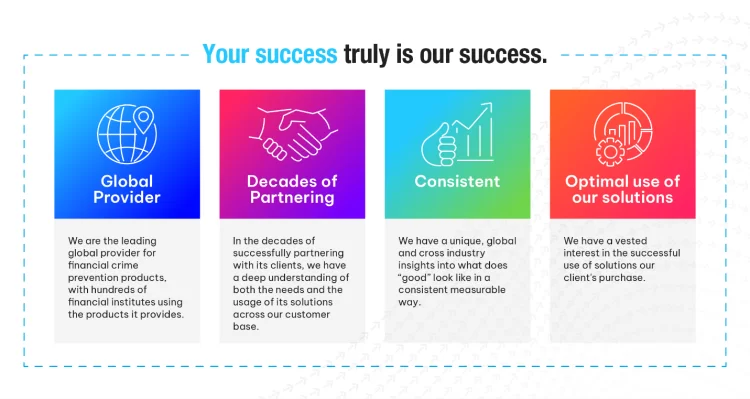Achieving Efficient & Meaningful Suspicious Activity Reporting
June 12th, 2025

After navigating the lengthy and complex process of financial crime prevention, detection and investigation, compliance teams must determine whether the activity subject of the investigation is deemed suspicious, and if that is the case, draft and submit a regulatory report. In the U.S. this typically entails generating a Suspicious Activity Report (SAR): a formal report submitted to the U.S. Treasury’s Financial Crimes Enforcement Network (FinCEN).
SARs are [primarily] written by Financial Institutions (FIs) but are also submitted by “Designated Non-Financial Business and Professions”(DNFBP), such as lawyers, accountants, real estate agencies. In most cases, a SAR starts when an investigator within a FI or other regulated entity observes a transaction, or group of transactions, that look suspicious. If the matter is worth further investigation or raises additional suspicions, the institution’s anti-money laundering (AML) Compliance Officer or Bank Secrecy Act (BSA) Officer (formally responsible to the Board for making such reports) will sign off and escalate the report.1
In 2023 alone, FinCEN filed approximately 4.6 million SARs2. This marked a continued increase in SAR filings (28% increase from the previous year and an estimated 57% from pre-pandemic levels)3, reflecting heightened efforts to combat financial crimes such as fraud, money laundering and human exploitation.
This article explores the importance of not only remaining compliant with regulatory reporting requirements but also how processes and technology can be combined to achieve better efficiency and quality in delivering SARs. and also how just reporting facts on a template is no longer an option for FIs.
Improvement needed: SAR-related regulatory enforcement
While SAR volumes continue to grow, regulators are also scrutinizing those volumes and, in some cases, as illustrated below, enforcing more thorough reporting standards through fines. This highlights the importance given to SARs as a crucial instrument in fighting financial crime and the role FIs play as a key line of defense within the overall public-private risk management framework:
- Deutsche Bank Securities Inc. was fined 4m USD by the Securities and Exchange Commission (SEC) for failing to file certain SARs in a timely manner. Some reports took more than two years to be filed.4
- TD Bank faced a record 1.3b USD penalty from FinCEN for violations of the BSA. The bank failed to maintain an adequate AML program, allowing illicit activities such as human trafficking and terrorist financing to go undetected. Control failures included missed SAR filings.5
Failure to meet SAR requirements is a growing concern not only in the U.S. but also across Europe, the Middle East and Africa (EMEA), where FIs have faced regulatory fines for noncompliance.
- The Federal Financial Supervisory Authority (BaFin), Germany’s financial regulator, imposed a 6.5m EUR (7.4m USD) fine on Solaris, a Berlin-based fintech company, for systematically failing to submit SARs on time. The fine highlighted ongoing concerns in the EU about money laundering risks across the financial sector, despite efforts to strengthen oversight.6
Turning SARs into actionable intelligence
Ultimately, SARs constitute another source for Financial Intelligence Units (FIUs – FinCEN in the US). Their real value lies in the usability of the data and information reported. This means SARs must reach their recipients in a timely fashion, contain the relevant case data and provide a narrative that can support further intelligence analysis downstream.
Ideally, SARs should clearly describe the actor(s) and type(s) involved, what specific activity they were allegedly performing, which geographies, products, services, currencies etc. were involved and what typology or [combination of] they were using. However, since SARs are written by humans from diverse backgrounds, training and experience, FIs often lack a consistent criteria that would enable SARs to be mapped to their crimes by the parties on the receiving end of the process.
The ability to effectively utilize intelligence is conditional on the quality of the reporting. An effective narrative, enriched with relevant information sources and structured in a logical sequence, is essential to quality reporting. This enables intelligence users to identify entities involved, timelines and jurisdictions, allowing for classification into a known typology or flagging for a potential new one.
Higher quality, actionable SARs enable FIUs to fulfill their role of liaising with law enforcement or prosecutors more efficiently, allowing the investigation to advance and effectively identify specific bad actors or illicit flows.
Deploying technology and services: AI & Operational Effectiveness
Regulatory Technology (RegTech) providers such as Actimize, are actively developing solutions that can be deployed along the “financial crime journey,” and SAR generation is no exception. For instance, Natural Language Processing (NLP) technologies can be powerful tools, leveraging artificial intelligence (AI) to analyze words and phrases within a document, enhancing context and understanding of their meaning and function.
AI efficiently extracts relevant data from various sources, and utilizing NLP, analyzes the extracted data to identify patterns, anomalies and potential red flags indicative of suspicious activity. An NLP system can leverage its understanding of the detected suspicious activity, permitting AI systems to autonomously construct clear and detailed SAR narratives. NLP ensures that narratives follow regulatory guidelines, include relevant details and effectively communicate the nature of the suspicious activity.
AI’s language generation capabilities ensure that SAR narratives are coherent, concise and adhere to regulatory language standards, checking for clarity, accuracy and completeness to enhance overall quality. AI systems are programmed to customize SAR narratives based on specific regulatory requirements and reporting standards and can even adapt to the nuances of different jurisdictions, ensuring compliance with an ever-changing landscape of financial regulations.
While AI contributes to the initial narrative construction, the process also allows human analysts to review and refine the generated content. Human oversight allows additional insight to be added and ensures that the narrative aligns with the broader context of the investigation.
By automating SAR narrative generation, AI not only accelerates the reporting process, but also improves the consistency and quality of the narratives submitted to regulatory authorities. Furthermore, this collaborative approach between AI and human analysts ensures a thorough and well-constructed SAR narrative, strengthening the institution’s ability to combat financial crimes effectively.
People and Processes
While AI enhances SAR reporting, processes governing SAR generation and supporting technology are managed by investigators. Human expertise provides critical contextual understanding, ethical considerations and the ability to navigate complex scenarios that AI may struggle to grasp. Financial crime investigators play a crucial role in interpreting AI-generated insights, validating findings and making judgments that contribute to more effective and ethical financial crime investigations, in what experts call “Human-Augmented AI.”7
The integration of AI within the SARs reporting process represents a significant advancement in the fight against financial crimes. AI addresses challenges like incomplete information and sub-standard narrative quality, empowering FIs, regulatory bodies and law enforcement agencies alike to proactively combat financial crimes.
As technology evolves, synergies between human expertise and AI capabilities will be instrumental in upholding the integrity of the global financial system. The current upsurge in SAR filings underscores the inevitability of embracing AI as a tool to enhance efficiencies across multiple areas. The key role investigators play reinforces the significance of a smooth integration between technology and human insight, leading to faster, more efficient and more ethical outcomes in SAR reporting, while helping FIs reduce operational costs.
Conclusions
While some voices in the industry claim the current SAR regime needs an overhaul, it seems clear that regulatory reporting, supported by skilled analysts and advanced technology, remains an essential tool in the current financial crime risk management framework.
A combined approach between different elements in that framework is what can effectively turn reports into meaningful, actionable intelligence. FIs should consider:
- Adapting to a fast-paced, changing technological landscape by embracing AI as part of a roadmap to enhanced efficiency.
- Ensuring data is accessible, high-quality and usable for AI-driven analysis—especially when criminals are already leveraging these technologies for their own purposes.
- Integrating technology and workflow automation with up-to-date efficient processes that are periodically reviewed, leaving humans to take the necessary and critical decisions.
- Following a human-centric approach, where investigators and senior management, supported by technology, take the relevant decisions and never lose sight of regulatory requirements concerning SARs.
How NICE Actimize can help
Let us help you on your changing journey and achieve sustainable success. Contact us today to schedule a consultation and learn how our industry expert team can assist you with:
- Identifying and assessing your end-to-end SAR reporting process, including key aspects like data, technology, processes, training and governance.
- Reviewing your current policies, operations processes and standing procedures against the changing background, helping you determine if they are still effective.
- Identifying areas for improvement.
- Setting realistic, measurable goals.
- Integrating best industry practices.
- Driving continuous improvement.
- Enhancing competitiveness.
1FFIEC: BSA Compliance Officer
2FinCEN releases year-in-review for FY 2023: SARs, CTRs and Information Sharing
3Thomson Reuters: SAR surge; 2023 filings on pace for another record
4Deutsche Bank Subsidiary to pay USD 4m for untimely filing certain suspicious activity reports
5FinCEN assesses record USD 1.3bn penalty against TD bank
7Forbes: AI Leadership’s blind spot: why human insight still drives success





